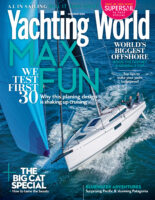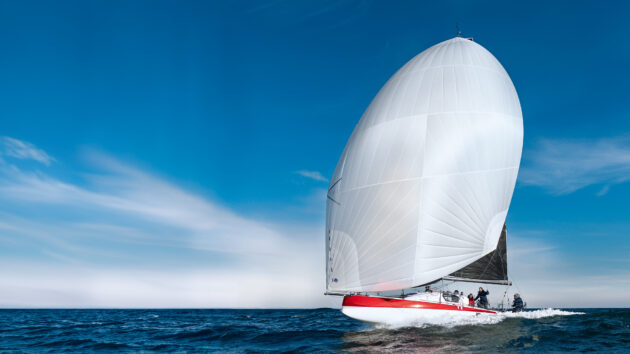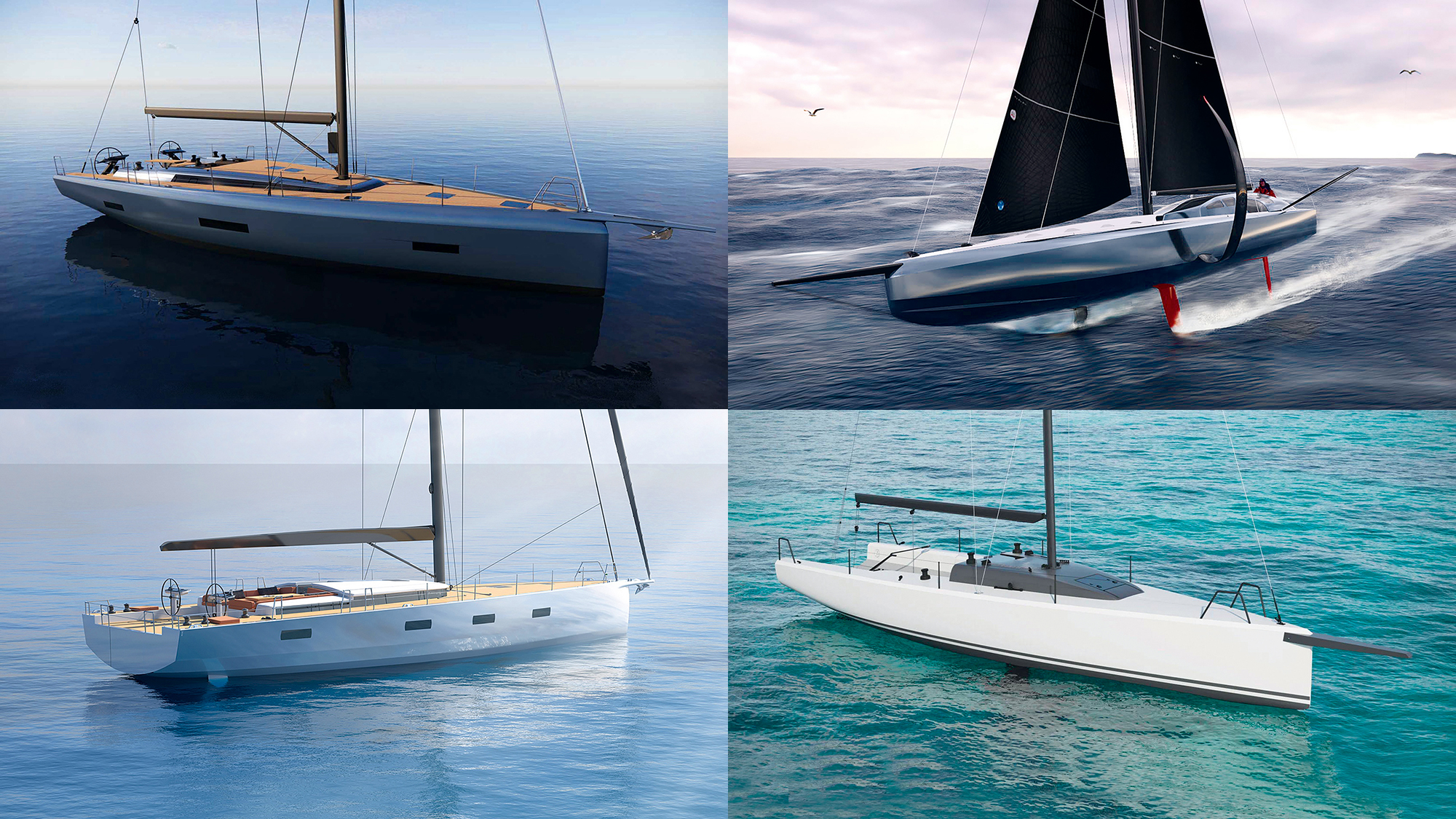The new Pogo RC promises a planing design with a competitive rating. Can this new 33-footer live up to the hype for offshore racing?
Pogo RC Review: Planing performance for shorthanded sailors
Having raced tens of thousands of miles on 33-36ft yachts optimised for IRC racing, I’ve long been frustrated by the perception that only relatively heavy designs can be competitive offshore. As a result, we’ve been sailing boats that, though capable of surfing fast in certain conditions, are nowhere near as exciting as they could be.
Historically, the trade off has been that planing boats of this size are slow in light airs and rarely sail upwind at speeds that match their rating.
However, two years ago Didier Gaudoux’s 35ft one-off Sam Manuard/Bernard Nivelt-designed Lann Ael 3 convincingly won both races, totalling 500 miles, of the IRC double-handed European championships. In doing so he proved it’s possible to design a lighter planing boat that can sail to its rating across a wide range of conditions.
Two French yards, Pogo Structures and JPK, have since developed versions of this concept into a production offering. It’s a major change of course for Breton yard Pogo, which until now has focused on Mini 650s and Class 40s, or its very fast cruising yachts that pay zero regard to any design considerations to optimise them for a rating system.
These are the first production-built competitive planing boats of a size that’s very popular with double-handed and solo sailors, yet also suitable for racing fully crewed.
I was able to test the Pogo RC in perfect marginal planing conditions, a couple of weeks before its first race. So, how does it perform, and what are the chances of it being able to sail to the Pogo ‘works’ boat’s relatively high rating of 1.064?
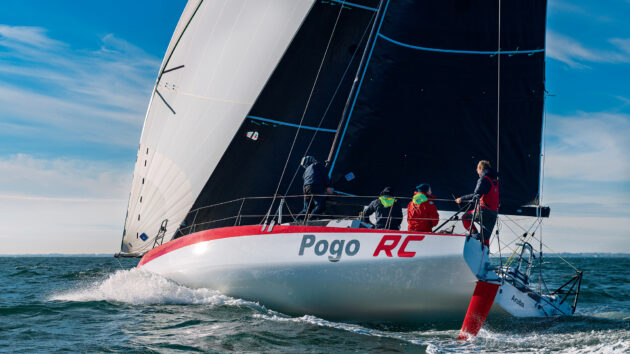
A radically different hull shape to the norm for offshore raceboats of this size promises exciting sailing while retaining a competitive rating. Photo: Jakez Le Gall
Heeled
We set off upwind in 13-16 knots of true wind. With full mainsail and J2 headsail the helm was finger-light and very responsive, with exactly the feel you’d expect of a light displacement boat. Yet it was easy to coax over the small but steep waves in the Anse de Benodet.
Equally, it proved easy to keep the boat in the groove at a consistent 25° apparent wind angle, equating to 45° to the true wind in these conditions. Boat speed was impressively quick, varying between 6.8 to 7.4 knots, depending on the wave pattern.
Article continues below…
Jeanneau Sun Fast 3300 review: The pocket rocket inspired by foiling IMOCAs
Jeanneau’s latest Sun Fast is a whole bundle of fun, as Pip Hare discovered on a full test of the…
7 next-generation fast monohulls coming to you this year
While the allure of multihulls has grown in recent decades, the there are still plenty of sailors looking for the…
Even with 200lt of water ballast, heel angles were relatively high at 28-29°, figures that are not dissimilar to those of scow bow Class 40s. Contrary to the expectations of many, these are incredibly quick upwind, compared to older Class 40 designs, providing they’re sailed well heeled.
The water ballast is an option aimed at those intending to race short-handed. There are 200lt tanks each side, plus a further 200lt centrally aft. Extra large diameter pipe is used for the plumbing, which makes filling and transferring impressively quick. Transferring in readiness for a tack, for example, takes less than 30 seconds, making short tacking a reasonably feasible operation.
We quickly left the stern wave behind after hoisting the 120m2 A2 spinnaker in 12-19 knots of true wind at a slightly hot TWA of 130-135° (and the apparent wind on the beam). Speeds were consistently in the 10-12 knot bracket, with frequent accelerations to 12.5 knots or more in the stronger puffs, all while retaining rock-steady control. Impressively, even in the biggest lulls, boat speed rarely dropped below 9 knots.
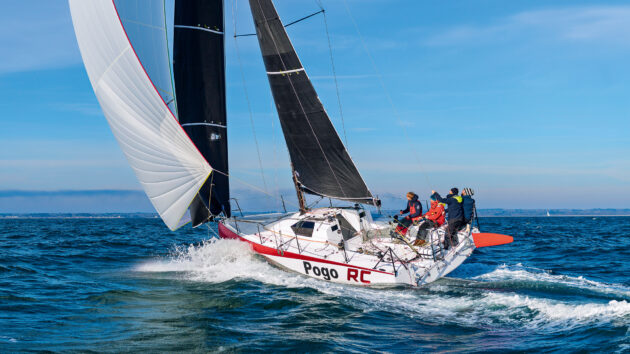
deck layout and kick up rudders set the boat apart. Photo: Jakez Le Gall
Design intricacies
The sail plan was developed with Fred Duthil of Incidence Sails, who this season is racing the boat with Tanguy Bouroullec, son of Pogo’s founder Christian, including a double-handed entry in the Rolex Fastnet Race. Duthil has made many small modifications for the works boat I tested that will be incorporated into subsequent yachts where the owners choose Incidence sails. However, the owner of hull No2 has chosen North, while the following one will have a suit from Doyle.
The test boat’s Code 0 is cut and sized to be as fast as possible at true wind angles of 55-60°. Reaching with both this and the J2 set in 15-17 knots of breeze, at a 40° apparent wind angle (70° TWA), we consistently achieved boat speeds of 8.5 to 11 knots. We were therefore effectively planing at times, even with the wind so far forward.
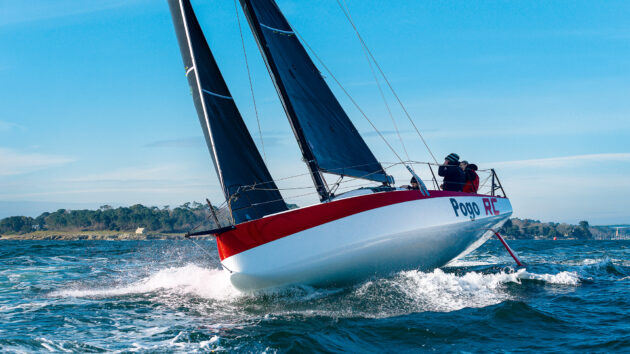
Left: wetted surface area reduces dramatically as heel increases. Photo: Jakez Le Gall
It’s important to recognise the hull shape of this boat has little in common with Pogo’s cruising yachts, which are created without any need for rating considerations. Designing a planing boat is not simply about minimising weight, or increasing sail area – the underwater shape of the hull is also critical. Pogo’s cruisers all have a very flat underwater profile. By contrast, the RC is a fundamentally different shape, with more rocker amidships and forward, though retaining the very flat run aft.
Waterline beam is surprisingly narrow, while the full bow sections have what the French call a spatula bow, with a long-ish overhang forward of the static waterline, plus a long smooth run aft. Unusually for today’s designs, waterline length is 20% shorter than the hull length.
Wetted surface area is therefore dramatically reduced, boosting performance in winds below 10 knots, with the compromise being that the RC will need a bit more power to start planing than Pogo’s cruising models. It also tends to sail with more heel when close-hauled than the cruisers, further reducing wetted surface area.
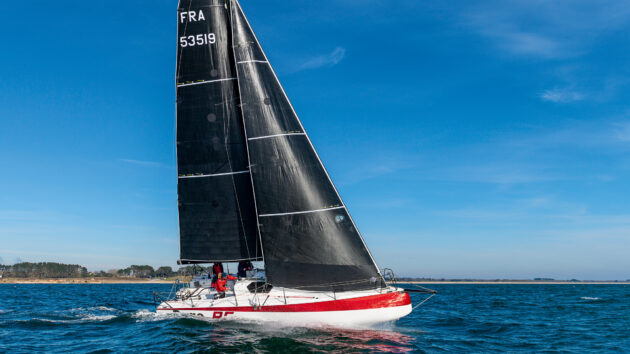
Upwind the boat is beautifully balanced and surprisingly fast. Photo: Jakez Le Gall
Doing things differently
Deck layouts and hardware are very thoroughly thought through, with systems and controls that fall easily to hand and work smoothly, without unnecessary friction.
A boat prepared to this level when it leaves the factory represents a huge advantage for owners who otherwise need to invest a tangible amount of time to refine the setup to a level at which they can be competitive.
Pogo has not been afraid to do things differently with the RC, which has eight winches on board, including those for backstays and the mainsheet. Constrictors were chosen instead of conventional clutches for three reasons. Firstly, they’re much kinder on the ropes, virtually eliminating wear caused by the clutch, they are also easily released even under full load, and save weight.
Pogo’s in-house team spent a lot of time with the deck plug in the yard at a pre-production stage, progressively optimising the deck layout and ergonomics. The outcomes of this process include increasing the width of the cockpit side decks.
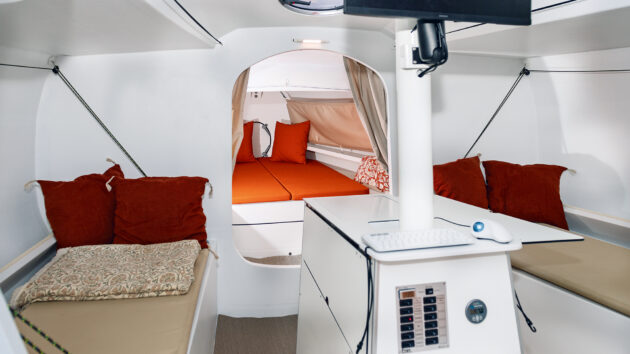
Centre console houses tankage and saloon table. Forepeak has sea toilet and a large double berth. Photo: Jakez Le Gall
Other neat ideas include kick-up rudders in the style of those for Class 40s and IMOCA 60s, but which are still rarely seen in IRC fleets. This system is neatly executed, with the backstay winch used to tension the downhaul line of the rudders. In addition, Code sails and nylon spinnakers are sheeted from the top of very substantial pushpits, giving greater flexibility for sheet leads. The first four boats are equipped with high-end pilots from Madintech, with B&G displays, while the fifth will have a complete set of NKE electronics.
Functionality at sea
The open plan interior is more comfortable than non-IRC raceboats of similar size, including the Beneteau Figaro 3 and Jeanneau Sun Fast 30, but the emphasis is firmly on functionality at sea and the arrangement is more basic than those of the other Sun Fast models and typical JPKs. Bright white surfaces give a fresh and airy feel, while the inside of the hull forms most of the cabin sole, giving greater headroom than might be expected.
A central console that dominates the middle of the interior houses a large 24in computer monitor. Each side of this are seats with a dual purpose, allowing you to take a quick nap without taking off foul weather gear, or sit to windward and swing the monitor round while working on navigation, weather and routing.
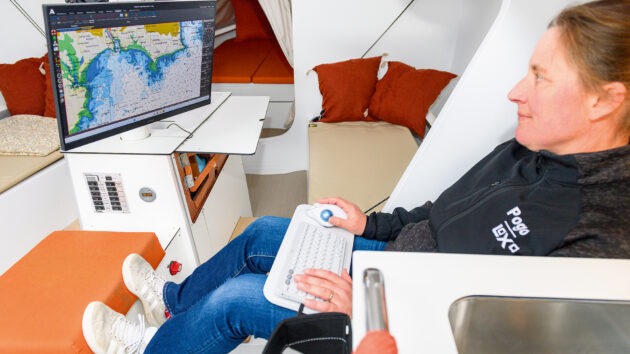
The monitor articulates, allowing the nav computer to be used from either side. Photo: Jakez Le Gall
Immediately aft of these seats is a basic galley and further aft a pair of quarter berths. These have pipe-cot bunks above them, allowing crew members to sleep well outboard, optimising weight distribution. Just inboard there’s also easily accessed sail stowage.
What would normally be the saloon area is rather short, with the ‘settees’ less than 6ft long and more likely to be used for sail stowage, though there is a central table with folding leaves. The forepeak houses both a large double berth and sea toilet, and can be closed off with a privacy curtain.
Pogo made considerable effort to keep weight down without resorting to exotic materials. All Pogo models are built with vacuum-infused mouldings, including the hull, deck, bulkheads and myriad of small parts. All structural elements are installed and glued in place before the hull is removed from the mould, ensuring it retains its designed shape.
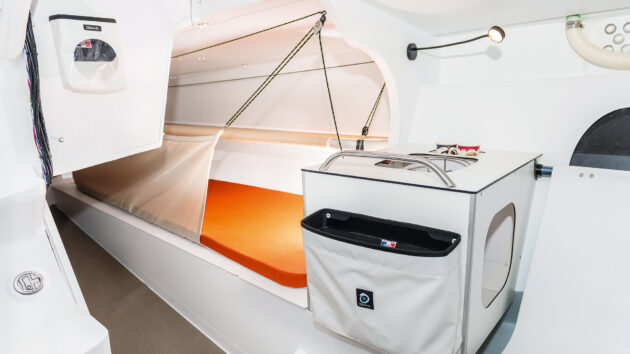
Here’s also a quarter berth aft on each side. Photo: Jakez Le Gall
Pogo RC specifications
Hull length: 10.25m / 33ft 8in
LWL: 8.17m / 26ft 10in
Beam: 3.54m / 11ft 7in
Draught: 2.25m / 7ft 5in
Displacement: 3,268kg / 7,205lb
Ballast (bulb weight): 612kg / 1,350lb
Upwind sail area: 70m2 / 753ft2
Downwind sail area: 160m2 / 1,722ft2
Design: Sam Manuard and Bernard Nivelt
Prices: from €222,078 ex VAT.
Typical on the water price (inc NKE electronics and pilot, but ex sails): €258,170 ex VAT
Price as tested: €285,832 ex VAT
Builder: pogostructures.com
 If you enjoyed this….
If you enjoyed this….
Yachting World is the world’s leading magazine for bluewater cruisers and offshore sailors. Every month we have inspirational adventures and practical features to help you realise your sailing dreams.Build your knowledge with a subscription delivered to your door. See our latest offers and save at least 30% off the cover price.
Note: We may earn a commission when you buy through links on our site, at no extra cost to you. This doesn’t affect our editorial independence.
Verdict
The Pogo RC may be a game changer in many respects. The IRC rating of the works boat at Spi Ouest was 1.064 – a significantly higher figure than is typical for Sun Fast 3300s, though slightly lower than the new JPK 1050. There’s no doubt about the Pogo RC’s planing performance and that it’s a fun and exciting boat to sail, with potential to be very quick reaching and downwind in stronger winds. But from the outset the big question has been: will it be able to hold its own upwind and in light airs? Ample evidence was provided in 6-10 knots wind on the second day of Spi Ouest, the boat’s first regatta. At the end of this 3 hour 40 minute race, Bouroullec and Duthil took 2nd place on corrected time, only 60 seconds behind the works JPK1050, sailed by the legendary pairing of Jean-Pierre Kelbert and Alexis Loison. Lann Ael 3 took 3rd. These new models are clearly shaking things up: they’re competitive in lighter winds, bring planing performance to a size range popular with short-handed sailors, yet are also equally suitable for fully-crewed teams. This is now the only raceboat Pogo is producing and with nine RCs sold before the first was launched, expect to see plenty of them on offshore races soon.

